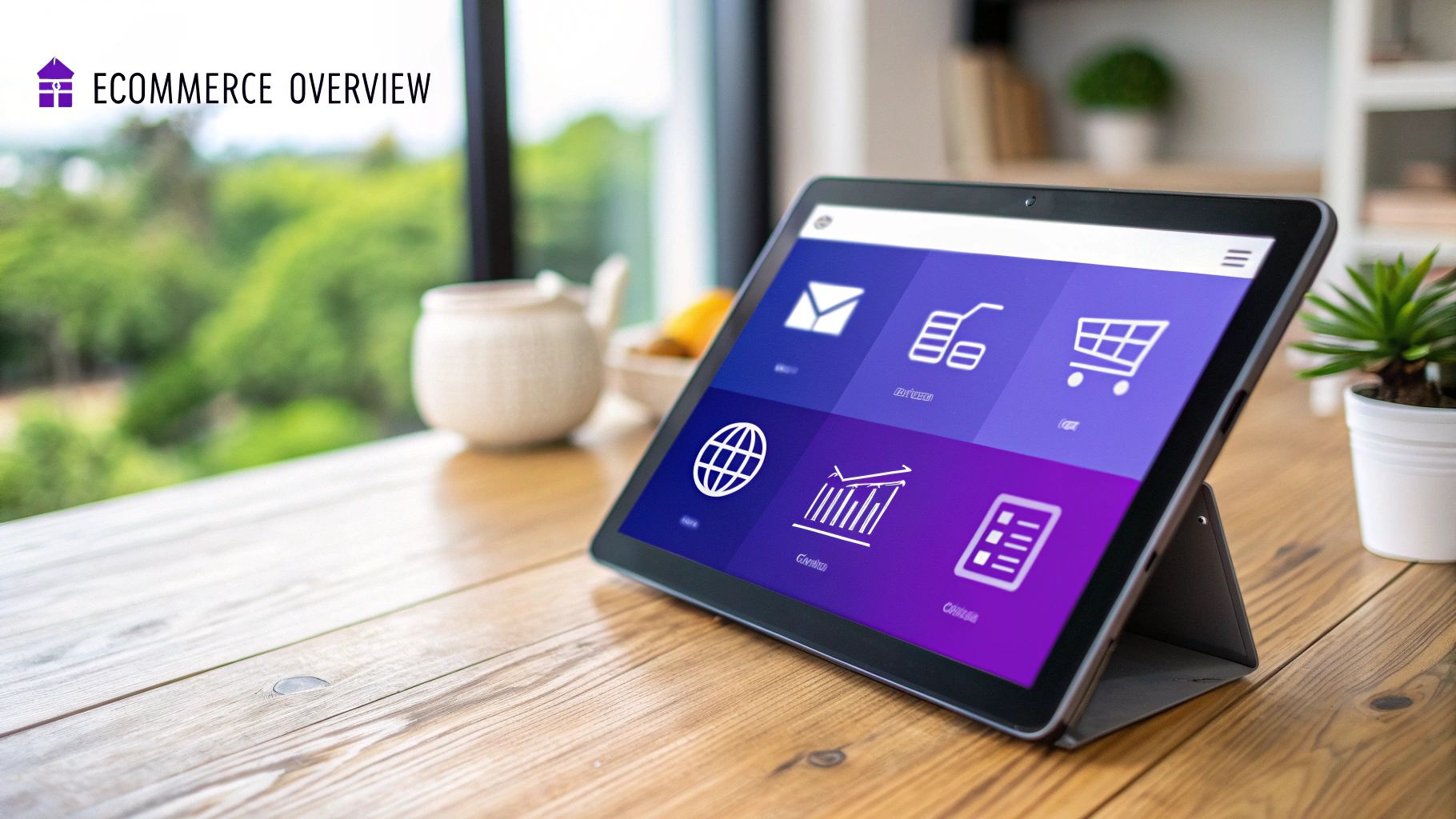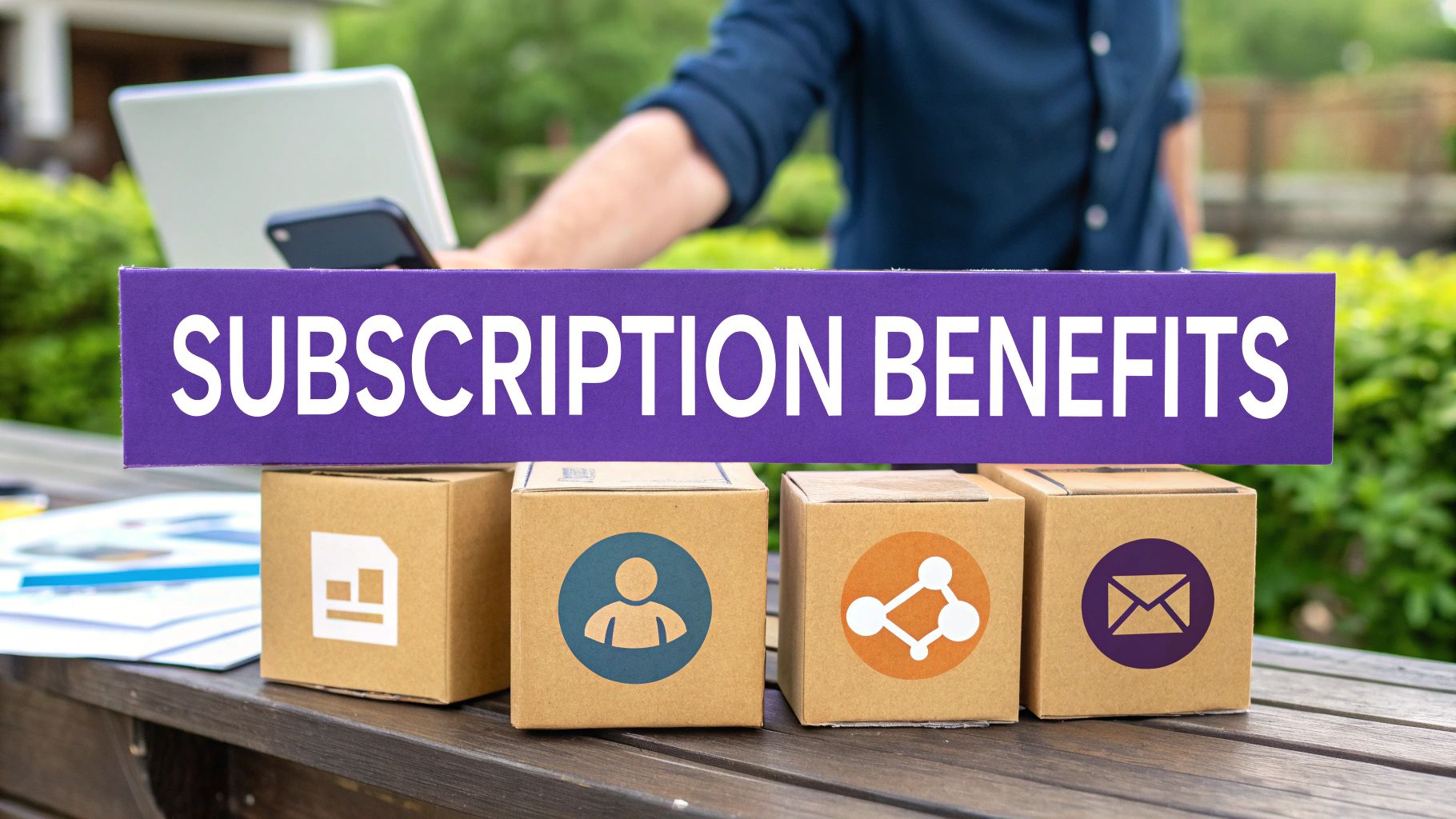The Subscription Revolution: Why Now Is the Time
The subscription model is reshaping how businesses operate and connect with their customers. It's more than just a fleeting trend; it represents a significant shift in consumer behavior. Increasingly, customers value access and experience over traditional ownership.
This change presents exciting opportunities for businesses willing to embrace the subscription economy. For those who hesitate, the risk of falling behind is substantial.
This shift is fueled by a desire for simplicity, personalization, and predictable pricing. Consumers appreciate the convenience of automated deliveries and the tailored experiences offered by subscription boxes.
For example, instead of purchasing individual products, customers can subscribe to a service that delivers curated selections based on their specific interests, whether it's coffee, cosmetics, or pet food. This personalized approach allows businesses to cultivate stronger customer relationships.

Financial Benefits of the Subscription Model
The subscription model also provides significant financial advantages for businesses. Recurring revenue creates predictability and enables better forecasting and inventory management. This stability is a major advantage for businesses facing market uncertainty.
This reliable revenue stream allows businesses to invest in growth and enhance their product offerings. These improvements further enhance the customer experience and foster stronger customer loyalty.
The growth of the ecommerce subscription market has been remarkable. The market has seen over 100% annual growth over the past five years, demonstrating the increasing demand for subscription-based services. This rapid expansion spans a wide range of industries, not just a few niche markets. Learn more at Recurly's Research Benchmarks for Subscription Ecommerce.
Industries Thriving in the Subscription Landscape
Which industries are seeing the most success with subscriptions? While growth is widespread, certain sectors stand out:
-
Replenishment Services: These services automate the delivery of essential goods like toiletries, cleaning supplies, and pet food.
-
Curation Services: Curated subscription boxes offer a personalized experience, delivering a selection of products tailored to individual preferences, from beauty items to hobby supplies.
-
Access Services: These subscriptions offer access to premium content, software, or services, generating recurring revenue and building customer loyalty.
The widespread adoption of the subscription model across diverse industries demonstrates its enduring relevance. Understanding these market trends is essential for businesses seeking to harness the power of recurring revenue. By adapting to these changes, businesses can position themselves for long-term success in the evolving subscription-focused landscape of ecommerce. Effectively managing these subscriptions is key to maximizing this growing market and building lasting customer relationships. This brings us to the next crucial aspect of thriving in the subscription economy: understanding the psychology of subscription buyers.
Decoding the Psychology of Subscription Buyers

Understanding customer motivations behind subscribing is crucial for thriving in ecommerce. It goes beyond simple convenience; there are underlying psychological factors at play. By grasping these drivers, businesses can craft subscription programs that truly resonate with their target audience. These insights are particularly helpful for Shopify store owners looking to optimize platforms like Tevello.
The Allure of Predictability and Control
One primary driver is the desire for predictability and control. Subscription services offer a sense of stability in our often unpredictable world. Knowing what to expect and when provides comfort, especially for essential items or frequently used products. This reliable delivery schedule also lessens the mental burden of remembering to reorder.
This predictable delivery cadence frees up mental energy for other tasks. Furthermore, the control offered by subscriptions, especially the ability to easily pause, modify, or cancel, enhances their appeal. This flexibility empowers customers and builds trust in the brand.
The Power of Personalization
Another significant psychological factor is the desire for personalization. Subscription boxes, for example, excel at catering to individual needs and preferences. This tailored approach makes customers feel valued and understood, strengthening their brand connection. A curated art supply box customized to a specific craft offers a far more engaging experience than a generic purchase.
This personalized touch is fundamental to successful subscription models. The ability to customize subscription options like delivery frequency and product variations strengthens this sense of individual control and deepens customer engagement.
The Value Proposition: Beyond Price
While price remains a consideration, subscription buyers often prioritize value over the lowest price point. The perceived convenience, personalization, and exclusive perks of subscriptions can easily justify a slightly higher cost. This perceived value transforms one-time buyers into loyal subscribers, especially for curated experiences or premium product/service access.
A considerable number of online shoppers have already adopted ecommerce subscriptions. Approximately 54% of online shoppers subscribe to a subscription box service, and roughly 15% utilize other ecommerce subscription services. This illustrates the growing popularity of subscription models, as highlighted by Invespcro's blog about the ecommerce subscription model. This trend underscores the importance of effective subscription management with tools like Tevello.
Building Lasting Subscriber Relationships
Understanding the psychology of subscription purchases empowers businesses to craft offerings with deeper customer resonance. This stronger connection fosters loyalty and reduces churn. Offering personalized onboarding, exclusive content, or early access to new products elevates the subscriber experience.
These tactics cultivate stronger relationships and significantly contribute to the long-term success of subscription programs. By nurturing these connections, businesses can build a loyal customer base and ensure sustained growth.
Generational Differences and Subscription Preferences
Recognizing generational differences in subscription preferences is also crucial for effective ecommerce subscription management. Younger generations might be attracted to the novelty and discovery aspect of subscription boxes, while older demographics may value the convenience and consistency of replenishment services.
To illustrate the varying conversion rates across demographics and subscription types, let's examine the following table:
Subscription Conversion Rates by Type Comparison of conversion rates across different subscription model types and consumer demographics
| Subscription Type | Average Conversion Rate | Primary Demographics | Retention Factors |
|---|---|---|---|
| Replenishment (e.g., toiletries) | 5-8% | Older demographics (35+) | Convenience, consistent supply |
| Curation (e.g., beauty boxes) | 2-5% | Younger demographics (18-34) | Novelty, discovery, personalization |
| Access (e.g., streaming services) | 3-6% | Broad range (18-55+) | Exclusive content, perceived value |
The table above highlights the importance of tailoring subscription offerings to resonate with the specific preferences of each target demographic. Understanding these nuances can significantly impact conversion and retention rates.
This targeted approach is vital for Shopify merchants aiming to expand their reach and effectively serve diverse customer segments. By understanding and addressing these varying needs, businesses can optimize their subscription strategies for maximal impact.
The Business Case: Financial Impact of Subscription Models

Beyond the hype, subscription models offer compelling financial benefits. These programs provide tangible advantages, from steady revenue streams to a significant increase in customer lifetime value (CLTV). This translates to more predictable income and stronger, long-term customer relationships.
Predictable Revenue and Improved Forecasting
One of the core strengths of the subscription model is its predictability. Recurring revenue allows for accurate financial forecasts, simplifying both budgeting and strategic planning. This consistent income provides stability, helping businesses navigate uncertain market conditions.
Knowing expected revenue also empowers businesses to make data-driven decisions. Investment planning becomes more straightforward, facilitating efficient resource allocation for future growth. This financial foresight offers a significant competitive advantage.
Enhanced Customer Lifetime Value
Effective subscription models dramatically enhance CLTV. By nurturing ongoing customer relationships, businesses cultivate loyalty and encourage repeat business. This consistent engagement generates higher revenue per customer than one-time purchases.
Consider a customer subscribing to a monthly coffee delivery service. They will likely spend more over time than someone making occasional coffee purchases. This increased CLTV is a key driver of profitability for subscription-based businesses. In fact, subscription businesses saw extraordinary growth between 2012 and 2018, expanding by over 300%. This outpaced S&P 500 company revenue growth by more than five times during the same period. See more statistics here.
Streamlined Operations and Reduced Costs
Subscriber data provides another compelling argument for subscriptions. This data allows for smarter inventory management, minimizing waste and optimizing stock levels. Efficient inventory practices reduce holding costs and improve overall profitability.
This data-driven approach also enables targeted marketing. By understanding subscriber preferences and buying habits, businesses can personalize their communications and offers, leading to improved conversion rates. Learn more about subscription models here.
Addressing Financial Challenges
While the advantages are clear, it's important to acknowledge the financial challenges inherent in subscription models. These include initial cash flow considerations and the investment needed for infrastructure. Careful planning and efficient ecommerce subscription management are vital.
Understanding the initial customer acquisition costs (CAC) is crucial. This includes marketing expenses and any discounts offered to new subscribers. Calculating the CAC helps determine the subscription program's overall profitability and informs decisions about pricing strategies and investment allocation.
Crafting Subscription Plans That Actually Convert

What separates a successful subscription business from one that falters? Often, the answer lies in the design of their subscription plans. This section delves into the crucial components of subscriptions that convert, going beyond the fundamentals to explore strategies that truly connect with customers and foster sustainable business growth. These insights are particularly relevant for Shopify store owners using platforms like Tevello to manage their subscriptions.
Pricing Psychology and Feature Allocation
Creating effective subscription plans requires a solid grasp of pricing psychology. It's not simply about setting a competitive price; it's about crafting options that align with how customers perceive value. This means carefully balancing features and benefits with their corresponding price tiers.
For instance, a basic plan with essential features offered at a lower price can attract budget-conscious customers. A premium tier with exclusive perks and advanced features can cater to customers who desire a more comprehensive experience. This tiered model allows businesses to attract a wider customer base while maximizing revenue.
The Art of the Free Trial and Frequency Options
Free trials are invaluable for converting hesitant customers. They provide a risk-free way to experience the product or service, reducing the barrier to entry for potential subscribers. The optimal trial period length depends on the complexity of what you offer.
A shorter trial may suffice for a straightforward product, while a more complex service may require a longer trial period. Beyond free trials, providing flexible frequency options – weekly, bi-weekly, or monthly – lets customers choose a delivery schedule that suits their needs, making your subscriptions even more enticing.
Cancellation Policies That Build Trust
A clear and customer-friendly cancellation policy can surprisingly boost conversions. By making cancellation easy, businesses build trust and alleviate concerns about long-term commitments. This transparency can be a key differentiator in a competitive market.
Data-Driven Optimization: Billing Cycles and Discounts
Successful subscription businesses use data to inform decisions. Analyzing customer behavior, churn rates, and revenue trends allows for continuous optimization. This data-driven approach ensures subscription plans are aligned with actual customer preferences and maximize profitability. Platforms like Tevello can assist Shopify store owners in tracking these vital metrics and making informed adjustments.
Comparing Subscription Plan Lengths
Different subscription lengths impact customer retention and revenue in varying ways. Analyzing these variations is critical for designing successful plans. The table below examines plan duration, its impact on retention, and the ideal use cases for each.
To understand how different subscription durations can influence your business, let's examine a comparison of common plan lengths:
Subscription Plan Length Comparison: Analysis of different subscription plan durations and their impact on retention and revenue
| Plan Duration | Average Retention Rate | Revenue Impact | Best Use Cases |
|---|---|---|---|
| Monthly | Moderate | Stable recurring revenue | Consumables, content subscriptions |
| Quarterly | Higher than monthly | Predictable revenue spikes | Seasonal products, curated boxes |
| Annual | Highest | Large upfront revenue, requires strong value proposition | Software, premium memberships |
Analyzing these data points helps businesses optimize for both short-term revenue and long-term customer loyalty. Understanding these nuances enables businesses to create subscription offerings that convert, retain customers, and drive sustainable growth. By selecting the right plan length for their specific product or service, businesses can tailor their offerings to meet customer needs and maximize their revenue potential.
Building Your Subscription Tech Stack That Scales
Building a solid tech foundation is essential for scaling your ecommerce subscription business. While the many options can seem daunting, focusing on core functions and avoiding common integration problems will put you on the path to success. This means carefully choosing the right platforms and tools for payment processing, subscription management, analytics, and customer engagement.
Essential Components of a Scalable Tech Stack
Your tech stack should be built to scale, ensuring it can handle a growing number of subscribers and changing business needs without needing constant revisions. A modular approach, selecting best-in-class solutions for each function that integrate seamlessly, is generally the best practice.
-
Payment Processing: A dependable payment gateway like Stripe is essential for processing recurring transactions securely. Look for features like automated retries for failed payments, support for various payment methods, and strong fraud prevention measures.
-
Subscription Management Platform: This is the core of your operation, managing everything from subscription creation and management to billing and renewals. Features like automated billing, flexible subscription options, and in-depth reporting are key. Tevello, for instance, provides robust subscription management features tailored for Shopify stores.
-
Analytics and Reporting: Data-driven insights are crucial for optimizing your subscription business. Select analytics platforms that offer detailed metrics on subscriber behavior, churn rates, and revenue trends. This data helps you identify areas for improvement and make informed decisions. Tools like Google Analytics can provide valuable data.
-
Customer Engagement Tools: Effective communication with subscribers is vital for retention. Email marketing platforms like Klaviyo , CRM systems such as HubSpot, and in-app messaging tools can help you build customer relationships and personalize the subscriber experience.
Avoiding Integration Pitfalls
Many businesses run into integration problems with different platforms. These issues can create data silos, inconsistent reporting, and inefficient workflows. Selecting platforms that offer pre-built integrations or APIs can minimize these issues. Check out our guide on features available with Tevello.
For example, make sure your subscription management platform integrates smoothly with your payment gateway and CRM system. This streamlined data flow gives you a unified view of your subscribers and enables more targeted communication. You might find this helpful: How to master integrations within Shopify for a deeper dive into integrations.
Choosing the Right Tools for Your Business Stage
The perfect tech stack will change as your business expands. Startups may focus on affordability and ease of use, while established businesses may need more advanced features and customization. This adaptable approach lets you tailor your tools to your current business needs and effectively manage growth.
-
Early Stage: Focus on budget-friendly, user-friendly tools with essential features. As your subscriber base increases, you can upgrade to more powerful platforms.
-
Growth Stage: Invest in platforms that provide scalability, automation, and advanced analytics to support rapid expansion. This helps manage increasing complexity and provides data for ongoing optimization.
-
Mature Stage: Consider enterprise-level solutions with extensive customization options and dedicated support to handle a large subscriber base. This specialized approach ensures your technology keeps supporting your business goals.
By focusing on these critical functions and making smart technology decisions, you can create a strong foundation for lasting success in the subscription economy. This proactive approach ensures your tech stack can handle growth and adjust to the shifting market demands.
Keeping Subscribers: Beyond Basic Retention Tactics
Retaining subscribers is essential for any thriving ecommerce subscription business. While acquiring new customers is important, minimizing churn is equally critical for long-term profitability. This means going beyond the basics and developing a proactive, nuanced approach to ecommerce subscription management.
Identifying Churn Risk Through Behavioral Signals
Successful subscription businesses recognize the value of data. By analyzing behavioral signals like product usage and email engagement, they can identify early warning signs of subscriber dissatisfaction. For example, a sudden decrease in product usage or a drop in email opens might indicate a potential churn risk. This proactive approach allows for intervention before issues escalate.
This preemptive strategy empowers businesses to act strategically. By noticing these subtle shifts in behavior, companies can reach out to at-risk subscribers with personalized offers or incentives, strengthening customer relationships and reducing churn.
Proactive Intervention Strategies: Pausing and Personalized Engagement
Instead of simply reacting to cancellations, proactive businesses implement intervention strategies. Offering strategic pausing options allows subscribers to temporarily suspend their subscriptions rather than canceling completely. This flexibility accommodates customers facing short-term financial constraints or changing needs, ultimately reducing the overall churn rate.
Furthermore, personalized engagement campaigns tailored to individual usage patterns can significantly boost retention. For instance, a customer who hasn't used a software subscription in a while might appreciate a targeted email highlighting new features or offering tutorials. This personalized touch shows subscribers they are valued and understood. Learn more in our article about how to master customer retention.
Strengthening Subscriber Relationships Through Communication
Open communication is key to building strong subscriber relationships. Addressing common cancellation triggers proactively can significantly impact retention. This includes clear communication about price changes, offering alternative subscription options, and providing outstanding customer service.
For example, promptly and empathetically resolving a customer's billing issue through support can transform a potentially negative experience into a positive one. This reinforces the subscription's value and strengthens the customer's bond with the brand.
Building Sustainable Subscriber Relationships
These strategies help businesses move beyond reactive retention to cultivate truly sustainable subscriber relationships. By understanding subscriber behavior, implementing proactive interventions, and fostering open communication, businesses can build a loyal customer base and drive long-term growth and profitability.
Ready to enhance your Shopify store with robust subscription features and community-building tools? Visit Tevello today and unlock the potential of recurring revenue.




